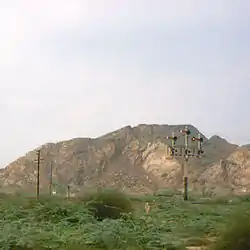
| Part of a series on |
| Punjabis |
|---|
 |
_with_cities.png.webp) Punjab portal |
Kirana Bar or Karana Bar forms part of the Bar Region in Pakistani Punjab.[1]
It is a portion of the Jech Doab, and it takes its name from the Kirana Hills found here. It covers the area between the western side of Chenab and the eastern side of Jhelum.[1][2][3]
The hills are not, as generally assumed, outliers of the Salt Range. This region is divided between the Sargodha and Jhang districts of Punjab, Pakistan. Bar stands for an area of natural jungle or wild forest and an area of human settlement as it was before colonisation by the British Government.[1]
This area starts from the northwest of Hissár country near the bank of river Chenab with an abrupt high ridge and this high bank of bar fades away a little distance east of the boundary of the Chiniot and Jhang tehsils, opposite the village of Kot Mohla.
The lands of the Kirana Bár to the east and south of the hills are of superb quality for agriculture.[2] After slight showers of rain, the whole land is carpeted with grass. Better rain crops are grown here than in the Sandal Bar. To the west of Kirana and westwards until the villages near the Jhelum River are reached, the bar soil deteriorates, and more and more kallar (water logging) is found. The Kirana bár is demarcated from the 'Utar' (North) by the same fall or slope as the Sandal Bar. Generally, this ledge forms the boundary between the villages and the Government waste grounds. But few villages possess lands beyond the high bank, or 'Nakka' as it is called. The flora of this Bár is much the same as that of the Sándal. Sajjí is produced to the southwest of Kirána. Some peculiar grasses grow on and near the hills, that are considered to be of most excellent quality.
See also
References
- 1 2 3 Mushtaq Soofi (13 June 2014). "Punjab Notes: Bar: forgotten glory of Punjab". Dawn (newspaper). Retrieved 26 May 2023.
- 1 2 Haroon Shuaib (19 March 2021). "Hafizabad: Romance of Rice". Youlin Magazine. Retrieved 26 May 2023.
- ↑ Anwar, Ayub. "The Role of Biraderies in the Politics of Faisalabad Division." Pakistan Vision 20.2 (2019): 11.